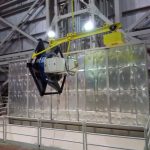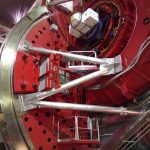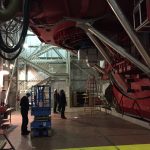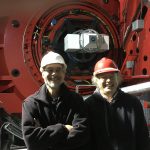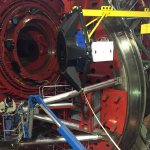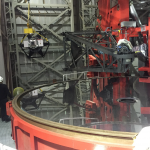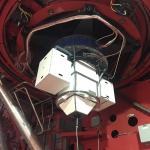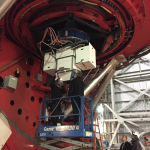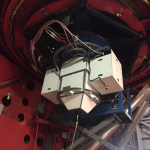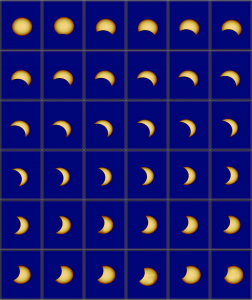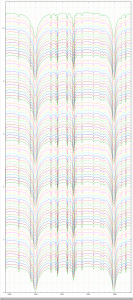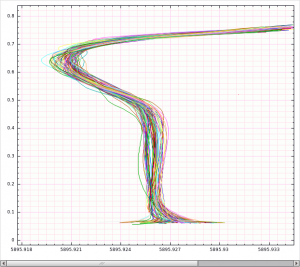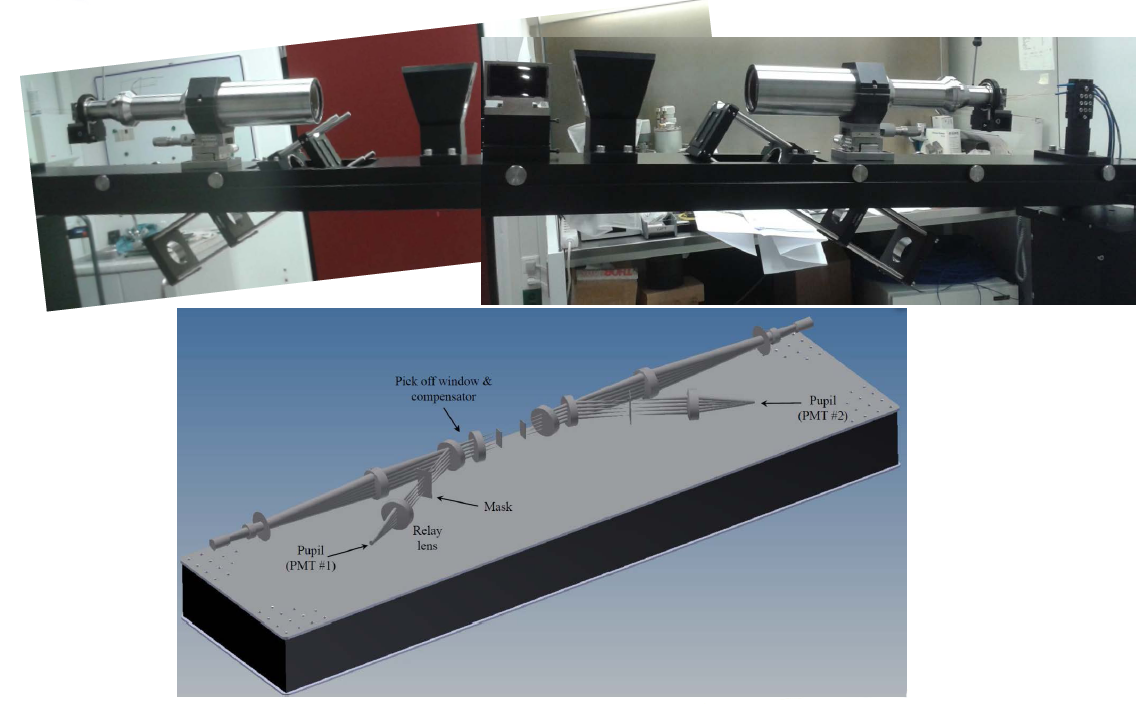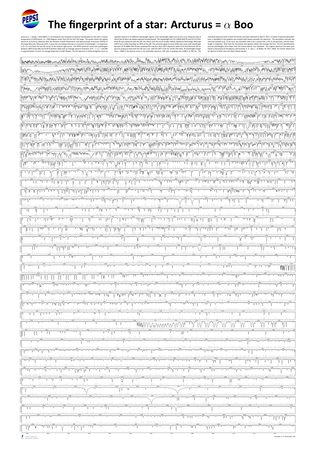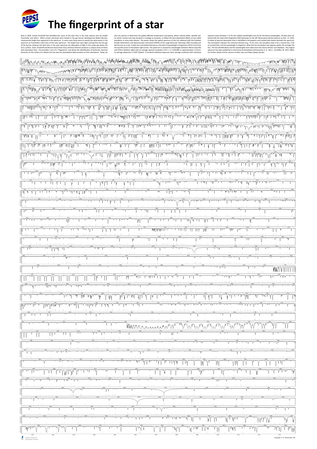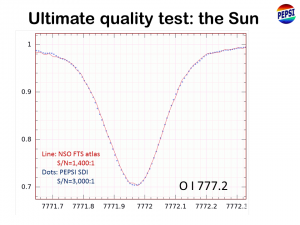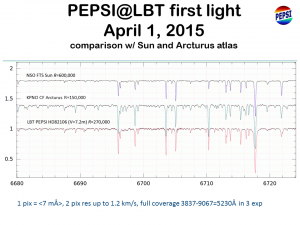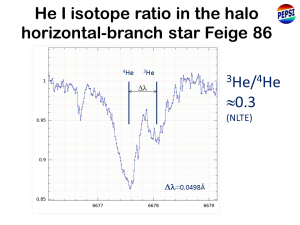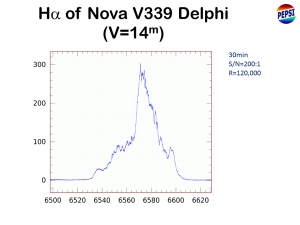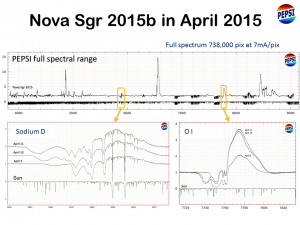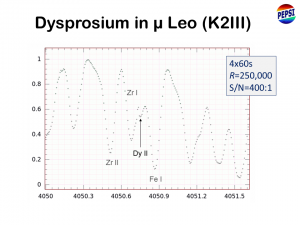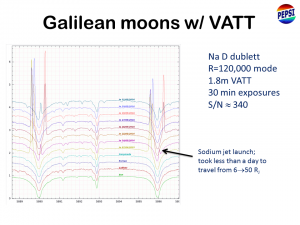- K. G. Strassmeier, I. Ilyin, M. Weber, A. Järvinen, S. Järvinen, A. Mott, M. Steffen, C. Mack III, D., Sablowski, A. Liermann, M., Mallonn, T. Carroll, & J. Storm
First spectra with the Potsdam Echelle Polarimetric and Spectroscopic Instrument - K. G. Strassmeier, I. Ilyin, M. Steffen, E. Dineva, C. Denker
A spectrum of the Sun - K. G. Strassmeier, I. Ilyin, M. Weber
PEPSI deep spectrum library - K. G. Strassmeier, P. Gabor, I. Ilyin, C. Corbally, A. Järvinen, S. Järvinen, D. Sablowski, T. A. Carroll, M. Weber
The VATT-PEPSI connection - C. Mack III, K. G. Strassmeier, I. Ilyin, S. Schuler, F. Spada
A chemical analysis of the ancient planet-host star Kepler-444 - I. Ilyin
PEPSI data reduction - I. Ilyin, A. Järvinen, K. G. Strassmeier, M. Weber, M. Woche, F. Dionies
Preparing for PEPSI polarimetry - S. P. Järvinen, T. A. Carroll, D. P. Sablowski, K. G. Strassmeier, I. Ilyin
First Doppler images with PEPSI - M. Mallonn, E. Keles, K. G. Strassmeier
Exoplanet spectroscopy with LBC, MODS and PEPSI: Silicate aerosols in the atmosphere of the hot Jupiter HAT-P-32b - J. Tayar (OSU), et al.
Tests of Convective Zone Radial Differential Rotation in Intermediate Mass Core Helium Burning Stars with PEPSI
Polarimeters saw first light, LBT gets polarized
The installation of PEPSI at the LBT was completed on September 6th when both its polarimeters were mounted in the straight foci of the LBT. During the night of September 10, 2017 the telescope was pointed to the magnetic standard star gamma Equ and a series of integrations in circularly and linearly polarized light were obtained. These spectra have a spectral resolution of R=120,000, covered four wavelength regions in the optical (two always simultaneously) and reached a S/N ratio of up to 600:1 in 6 min integrations. The telescope was just tracking and not guiding yet nor were the wavefront sensors actively collimating the telescopes. The image quality was controlled by eye (by John Hill remotly from Tucson). Because the polarimeters for each of the LBT telescopes are identical and modular in design, circular and linear polarization may be obtained simultaneously. We used the SX side for circular and the DX side for linear polarization. A total of 12 exposures were obtained.
Image gallery
Partial solar eclipse observed by SDI
August 21, 2017. The partial solar eclipse was observed at Mt.Graham in Arizona remotely from AIP with the Solar Disk Integrated Telescope (SDI) which guides on the Sun and feeds the light into the PEPSI high-resolution spectrograph in the pier of the LBT telescope. The partial eclipse began on 09:16 MST and ended at 12:03 MST.
One hundred spectra were obtained during the course of the eclipse in two wavelength regions 422-477 and 536-628 nm with the resolving power 270 000 (1100 m/s in radial velocity per resolution element). The spectra obtained are highly dynamic as the area of the line formation changes, hence, the shape of the lines is slightly alternating. We perform analysis of the Sodium D1 line 589.59 nm which is formed in the lower chromosphere of the Sun above 500 km of its photosphere. Its bisector (i.e. the central wavelength at different depths of the line profile) shows large changes in the line core which is formed in the higher chromospheric layers.
Spectrum poster of Epsilon Eridani
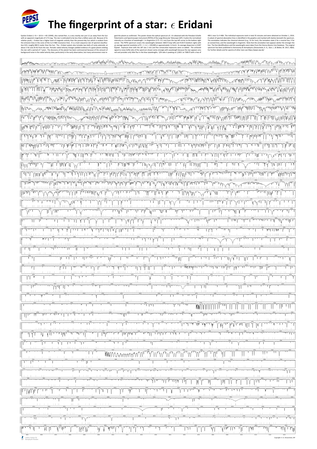 The poster shows the optical spectrum of Epsilon Eridani obtained with the Potsdam Echelle Polarimetric and Spectroscopic Instrument (PEPSI) of the Large Binocular Telescope (LBT).
The poster shows the optical spectrum of Epsilon Eridani obtained with the Potsdam Echelle Polarimetric and Spectroscopic Instrument (PEPSI) of the Large Binocular Telescope (LBT).
Fibre coupling updated
Spectrum poster of Arcturus
The poster shows the optical spectrum of Arcturus obtained with the Potsdam Echelle Polarimetric and Spectroscopic Instrument (PEPSI) of the Large Binocular Telescope (LBT).
Spectrum poster of the Sun obtained with SDI
The poster shows the optical spectrum of the Sun obtained with the Potsdam Echelle Polarimetric and Spectroscopic Instrument (PEPSI) of the Large Binocular Telescope (LBT) recorded just like the Sun-as-a-star.
Lithium in the active sub-giant HD123351. A quantitative analysis with 3D and 1D model atmospheres using different observed spectra
Here we present a spectroscopic comparative analysis of the Li doublet region of HD 123351, an active sub-giant star of solar metallicity. We fit the Li profile in three observed spectra characterized by different qualities: two very-high resolution spectra (Gecko@CFHT, R=120 000, SNR=400 and PEPSI@LBT, R=150 000, SNR=663) and a high-resolution SOPHIE@OHP spectrum (R=40 000, SNR=300). We adopt a set of model atmospheres, both 3D and 1D, having different stellar parameters (T_{eff} and log g). The 3D models are taken from the CIFIST grid of COBOLD model atmospheres and departures from LTE are considered for the lithium components. For the blends other than the lithium in this wavelength region we adopt the linelist of Melendez et al. (2012, A&A, 543, 29). We find consistent results for all three observations and an overall good fit with the selected list of atomic and molecular lines, indicating a high 6Li content.
The presence of 6Li is not expected in cool stellar atmospheres. Its detection is of crucial importance for understanding mixing processes in stars and external lithium production mechanisms, possibly related to stellar activity or planetray accretion of 6Li-rich material.

Read more: Mott, Steffen, Caffau, & Strassmeier 2017, MemSAI 88, 68
Spectrum gallery from commissioning
CoRoT photometry and STELLA spectroscopy of an eccentric, eclipsing, and spotted HgMn binary with sub-synchronized rotation
Context. We report the discovery and analysis of very narrow transits in the eccentric spectroscopic binary HSS 348 (IC 4756).
Aims: The aim is to characterize the full HSS 348 system.
Methods: We obtained high-precision CoRoT photometry over two long runs and multi-epoch high-resolution échelle spectroscopy and imaging with STELLA and first PEPSI spectra.
Results: HSS 348 is found to be an eccentric (e = 0.18) double-lined spectroscopic binary with a period of 12.47 d in which at least the primary component is a peculiar B star of the HgMn class. The orbital elements are such that the system undergoes a grazing eclipse with the primary in front but no secondary eclipse. The out-of-eclipse light variations show four nearly equidistant but unequal minima stable in shape and amplitude throughout our observations. Their individual photometric periods are all harmonics of the same fundamental period which happens to agree with the transit period to within the errors. We interpret the fundamental period to be the rotation period of at least one if not both stars due to surface inhomogeneities. Due to the non-zero eccentricity of the orbit the two components are rotating sub-synchronously.
Conclusions: It appears that HSS 348 is not a member of the IC 4756 cluster but a background B8+B8.5 binary system. Its sharp eclipses every 12.47 days just mimic a small-body transit but are in reality the grazing eclipses of a B-star binary and thus a classical false positive. The system seems to be pre-main sequence with the primary possibly just arrived on the ZAMS. The light curve with four unequal minima can be explained with four cool spots of different size equidistantly positioned in longitude. Our data do not allow to uniquely assign the spots to either of the two stars.

Read more: Strassmeier et al. 2017, A&A 597, A55

